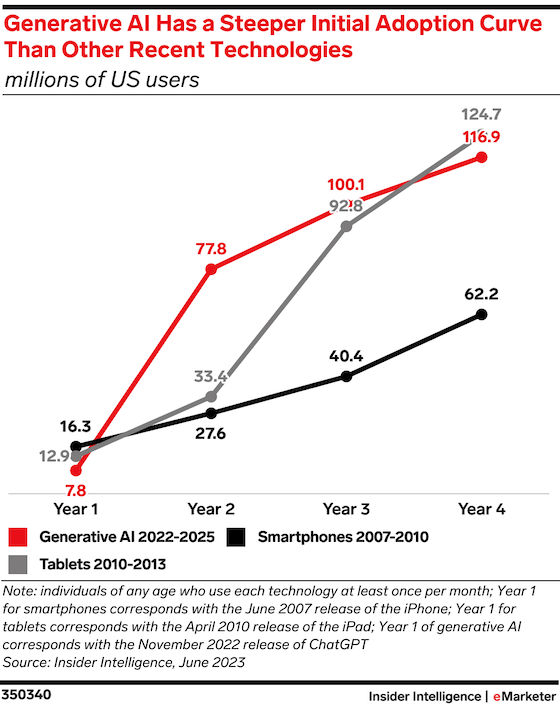According to recent research by Emarketer, generative AI tools, such as ChatGPT, are enjoying rapid adoption, which is much faster than the adoption of smartphones and tablets after their market introduction. The reason is the low entry barrier. Unlike smartphones and tablets, generative AI does not require the purchase of new hardware. People can access ChatGPT and similar tools on devices they already own.
Growth of Generative AI in Numbers
Generative AI reached over 100 million users just two months after the launch of ChatGPT. In contrast, smartphones took more than two years to reach 100 million users after the iPhone was introduced in 2007. Tablets reached 75 million users approximately two years after the iPad was launched in 2010. Thus, the adoption of generative AI has significantly outpaced both of these categories.

Image source: eMarketer
Demographic Trends in Generative AI
According to Emarketer, the adoption of generative AI among 18-34-year-olds is nearly double compared to older demographic groups. Younger generations are more digitally adept and are early adopters of new technologies, such as generative AI.
Applications of Generative AI
While generative AI has been around for some time, it has recently seen a massive surge in popularity. Users are enthusiastically experimenting with tools like ChatGPT for poetry creation, Midjourney for art generation, and AI chatbots from companies like Google and Microsoft integrated into search.
Opportunities and Risks for Marketers
For SEO specialists and digital marketers, generative AI presents both opportunities and risks. AI-driven search, such as Google's Search Generative Experience (SGE), aims to improve search quality. However, there are concerns that SGE might promote more low-quality content.
Looking to the Future
As generative AI continues to evolve, marketers should closely monitor developments. With careful testing and evaluation, there is potential to harness these tools while minimizing possible downsides.
Source: Search Engine Journal





